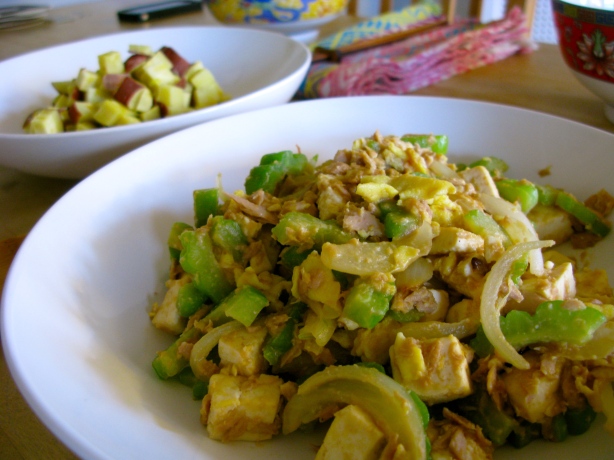As I head off for a long weekend of uber-indulgence in Colorado (think Freshcraft to Strange Brewing to Great Divide to Falling Rock to Oskar Blues to Lefthand to New Belgium to Odell’s to Funkwerks to…liver failure and a broken home?) I wanted to leave you with the recipe for my last supper before the storm.
In an attempt to set my body so straight that it can only get so out of whack, I “traveled” to Okinawa, Japan’s island prefecture famous for its inhabitants’ long lives and excellent health. I figured taking some cues from their kitchens might just lend me some of their resilience.
And this means I get to use one of my favorite funny looking produce items: bitter melon! This bumpy fruit is prized among Okinawans and is often credited with, well, just about everything. Seriously this thing had been used by populations all over the world for centuries to treat ailments ranging from stomach pains to nema toads to measles to diabetes to dysentery to scabies to cancer to malaria to — get this — HIV. And there’s actually science behind it. Like whoa.
The one catch is, well, it’s bitter. Certainly an acquired taste. There are things you can do to reduce the astringency, but its got a bite no matter what. Me? I love it. My boyfriend? Not so much. But considering that its basically a miracle in a melon, don’t you think you should like it no matter what?
To really get at the heart of this amazing community of folks, I sprung for a foundational Okinawan dish: Goya Chanpuru. It’s basically the Okinawan version of bi bim bap or donburi — a meal in a bowl — but features traditional Okinawan ingredients. To go the extra mile, I served mine with boiled satsuma-imo, the purple-skinned Japanese sweet potato cultivar. It is often said that Okinawans love this yammy bugger so much that it is often eaten boiled and cubed in the place of rice — perhaps contributing to their overall health and well being. Doesn’t much matter though, because they’re delicious anyway!
To sum up how I feel about this dish, I was absolutely unable to follow the traditional Okinawan rule hara hachi bu. Putting down the chop sticks at 80% full? There was no way. I stuffed my face. Addictive.
Goya Chanpuru with Boiled Satsuma-Imo
Serves 2-3 (can be vegetarian, vegan, and/or gluten free)
- 1 small bitter melon (select firm, yellow-green melons, about 5-6″ long)
- 1/2 small yellow or white onion
- 1/2 block of extra firm tofu
- 1/2 can of tuna (for vegans use 1/2 cup cubed ham substitute or seitan)
- 1 egg (for vegans use your favorite vegan egg scrambler substitute)
- 1 large or 2 small Japanese sweet potatoes
Condiment Sauce
- 2 tbs white miso (rice, buckwheat, or millet based if gluten free)
- 2 tbs sake
- 1/2 tbs sugar
- 1 tsp tamari
Boil scrubbed potatoes in water until easily pierce-able with a fork (and then once cooled slightly have someone else cut them into cubes while you cook the chanpuru 🙂).
Meanwhile, whisk condiment ingredients together and set aside.
Also, crack the egg into a bowl, beat well and set aside.
Then, slice the bitter melon down the middle. Scoop out the seeds and most of the white innards. Slice into half moons about 1/8-1/4″ thick. Place the slices in a colander and sprinkle with salt. Let sit for 10 minutes (this will remove some of the bitterness).
Meanwhile, wrap tofu in a paper towel and press the water out. Wrap in a new sheet and place in microwave for 20-30 seconds. Press more water out. Wrap in new sheet and press one more time. Then cube! About 1/2″ square.
Cut the onion into half moons.
Once 10 minutes has passed, pat the bitter melon dry with a paper towel.
Then start cookin’!
Coat the bottom of your saute pan or wok with non-stick spray, heat over medium and add egg. Let spread and cook until just firm, but still runny, and then set remove from pan and set aside – like a loose-y goose-y omelet.
Add 1-2 tsp of sesame oil to the same pan, let heat up and then add the bitter melon. Saute for a minute or two, then add onion. Saute for another minute or two, until just lightly softened and starting to brown. Add tofu cubes, continuing to move the whole mixture around your pan. Let saute for a few minutes, then add tuna (or vegan meat), incorporating well. Mix the egg back in, not being afraid to jostle tofu cubes. You don’t have to be gentle with this!
Lastly, slowly pour the condiment sauce around the rim of the pan and mix in.
Serve with the steamed satsuma-imo cubes your friend so nicely cut up for you.
Then, LIVE LONG AND PROSPER.
In Colorado.











